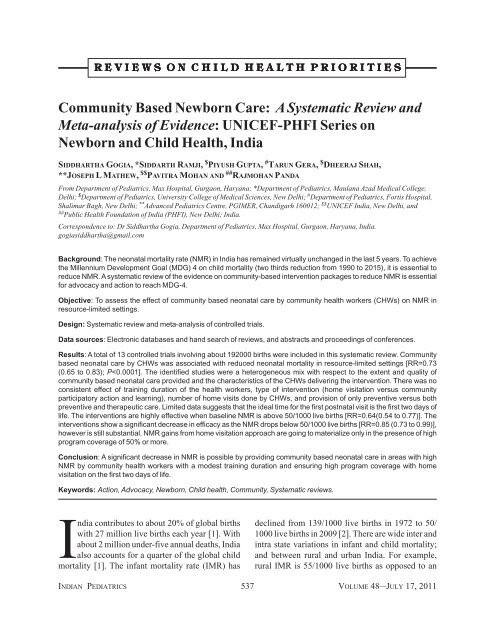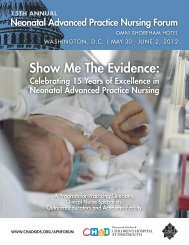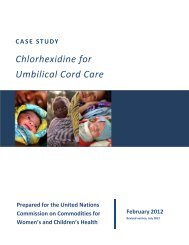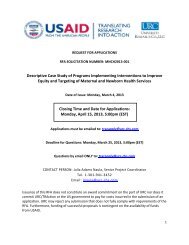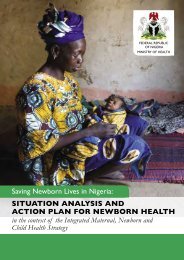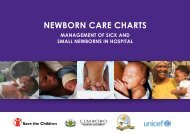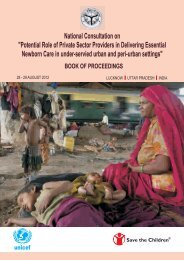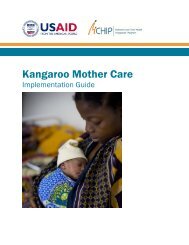A Systematic Review and Meta-analysis of Evidence - Healthy ...
A Systematic Review and Meta-analysis of Evidence - Healthy ...
A Systematic Review and Meta-analysis of Evidence - Healthy ...
Create successful ePaper yourself
Turn your PDF publications into a flip-book with our unique Google optimized e-Paper software.
R E V I E W S O N C H I L D H E A L T H P R I O R I T I E S<br />
Community Based Newborn Care: A <strong>Systematic</strong> <strong>Review</strong> <strong>and</strong><br />
<strong>Meta</strong>-<strong>analysis</strong> <strong>of</strong> <strong>Evidence</strong>: UNICEF-PHFI Series on<br />
Newborn <strong>and</strong> Child Health, India<br />
SIDDHARTHA GOGIA, *SIDDARTH RAMJI, $ PIYUSH GUPTA, # TARUN GERA, $ DHEERAJ SHAH,<br />
**JOSEPH L MATHEW, $$ PAVITRA MOHAN AND ## RAJMOHAN PANDA<br />
From Department <strong>of</strong> Pediatrics, Max Hospital, Gurgaon, Haryana; *Department <strong>of</strong> Pediatrics, Maulana Azad Medical College,<br />
Delhi; $ Department <strong>of</strong> Pediatrics, University College <strong>of</strong> Medical Sciences, New Delhi; # Department <strong>of</strong> Pediatrics, Fortis Hospital,<br />
Shalimar Bagh, New Delhi; ** Advanced Pediatrics Centre, PGIMER, Ch<strong>and</strong>igarh 160012; $$ UNICEF India, New Delhi, <strong>and</strong><br />
## Public Health Foundation <strong>of</strong> India (PHFI), New Delhi; India.<br />
Correspondence to: Dr Siddhartha Gogia, Department <strong>of</strong> Pediatrics, Max Hospital, Gurgaon, Haryana, India.<br />
gogiasiddhartha@gmail.com<br />
Background: The neonatal mortality rate (NMR) in India has remained virtually unchanged in the last 5 years. To achieve<br />
the Millennium Development Goal (MDG) 4 on child mortality (two thirds reduction from 1990 to 2015), it is essential to<br />
reduce NMR. A systematic review <strong>of</strong> the evidence on community-based intervention packages to reduce NMR is essential<br />
for advocacy <strong>and</strong> action to reach MDG-4.<br />
Objective: To assess the effect <strong>of</strong> community based neonatal care by community health workers (CHWs) on NMR in<br />
resource-limited settings.<br />
Design: <strong>Systematic</strong> review <strong>and</strong> meta-<strong>analysis</strong> <strong>of</strong> controlled trials.<br />
Data sources: Electronic databases <strong>and</strong> h<strong>and</strong> search <strong>of</strong> reviews, <strong>and</strong> abstracts <strong>and</strong> proceedings <strong>of</strong> conferences.<br />
Results: A total <strong>of</strong> 13 controlled trials involving about 192000 births were included in this systematic review. Community<br />
based neonatal care by CHWs was associated with reduced neonatal mortality in resource-limited settings [RR=0.73<br />
(0.65 to 0.83); P
GOGIA, et al.<br />
urban IMR <strong>of</strong> 34 per 1000 live births [2]. A<br />
significant proportion <strong>of</strong> child deaths (over 50% <strong>of</strong><br />
under-five mortality <strong>and</strong> 66% <strong>of</strong> infant mortality)<br />
occur in the neonatal period [2]. According to 2008<br />
estimates, out <strong>of</strong> the annual 1,829,826 under five<br />
deaths, 1,003,767 (54.8%) occurred in the neonatal<br />
period. Early neonatal mortality (25/1000 live births)<br />
accounts for 2/3 <strong>of</strong> neonatal mortality [2]. Preterm<br />
birth (32.4%), neonatal infections (26.7), <strong>and</strong><br />
complications <strong>of</strong> birth asphyxia/trauma (18.9%)<br />
account for most neonatal deaths [3].<br />
With the advent <strong>of</strong> Janani Suraksha Yojana (cash<br />
incentive scheme for institutional delivery), certain<br />
important parameters <strong>of</strong> maternal health have shown<br />
impressive gains; institutional delivery has increased<br />
to 72.9%, safe delivery by skilled birth attendants<br />
has increased to 76%, <strong>and</strong> mothers who had 3 or<br />
more antenatal check-ups has also increased to<br />
68.7% [4]. However, 46% <strong>of</strong> mothers stay for less<br />
than or equal to 1 day at the health facility after<br />
childbirth [4]. Majority <strong>of</strong> neonatal deaths are<br />
occurring at home, within the first few days <strong>of</strong> life,<br />
against a backdrop <strong>of</strong> rural poverty, unskilled<br />
neonatal care, <strong>and</strong> probable suboptimal/absent<br />
referral system. Only 22.2% neonatal deaths occur in<br />
a health facility [3].<br />
The Millennium Development Goal (MDG)-4 on<br />
child mortality for India aims for a two-thirds<br />
reduction in IMR from the 1990 level <strong>of</strong> 84/1000 live<br />
births to 28/1000 live births by 2015. The National<br />
Rural Health Mission (NRHM) in India has set itself<br />
the goal <strong>of</strong> reducing IMR to 30/1000 live births by<br />
2012. However, at the present rate <strong>of</strong> decline in IMR,<br />
the likelihood <strong>of</strong> achieving these targets appears<br />
unlikely, given that two-thirds <strong>of</strong> infant deaths are<br />
contributed by neonatal deaths, wherein the<br />
mortality decline has been woefully small. Since<br />
utilization <strong>of</strong> health facilities for neonatal health is<br />
low, there is a need to review the potential<br />
complementary role for community based newborn<br />
care in accelerating the decline in neonatal deaths to<br />
achieve the MDG-4 goals. Recent reviews have<br />
evaluated the efficacy <strong>and</strong> cost-effectiveness <strong>of</strong><br />
individual interventions in reducing neonatal<br />
mortality, <strong>and</strong> packages <strong>of</strong> interventions have been<br />
proposed for wide-scale implementation [5].<br />
However, there are only a few systematic reviews on<br />
COMMUNITY BASED NEWBORN CARE<br />
community health inter-ventions for newborn<br />
survival [6]. This systematic review was undertaken<br />
to assess the effect <strong>of</strong> community based neonatal<br />
care interventions on neonatal mortality in resourcelimited<br />
settings, <strong>and</strong> explore its relevance for India.<br />
METHODS<br />
Inclusion Criteria for Trials<br />
Type <strong>of</strong> trials: Trials (r<strong>and</strong>omized or quasir<strong>and</strong>omized)<br />
evaluating interventions including<br />
community based neonatal care by community<br />
health workers, with individual or cluster allocation,<br />
were eligible for inclusion. Trials evaluating specific<br />
community based interventions e.g. micronutrient<br />
supplementation, vaccination, cord cleansing with a<br />
specific disinfectant, kangaroo mother care, breast<br />
feeding counseling, antimalarial treatment etc were<br />
excluded.<br />
Participants: Neonates (first 28 days <strong>of</strong> life, or the<br />
first month <strong>of</strong> life where not specified in days) born<br />
in resource limited settings.<br />
Interventions: Interventions during pregnancy could<br />
include any one or more <strong>of</strong> the following: (i)<br />
Promotion <strong>of</strong> antenatal care; (ii) Health education<br />
<strong>and</strong>/or counseling regarding desirable practices<br />
during pregnancy; or (iii) Promotion <strong>of</strong> delivery in a<br />
hospital or at home by a skilled birth attendant; or (iv)<br />
Education about safe <strong>and</strong>/or clean delivery practices.<br />
Interventions during childbirth could include<br />
implementation <strong>of</strong> safe delivery practices in case <strong>of</strong><br />
domiciliary deliveries <strong>and</strong> care <strong>of</strong> the newborn<br />
immediately after birth, including keeping the baby<br />
warm, neonatal resuscitation (if required), <strong>and</strong> early<br />
initiation <strong>of</strong> breastfeeding.<br />
Interventions during neonatal period could<br />
include any <strong>of</strong> the following: (i) Promotion <strong>of</strong><br />
optimal neonatal care practices such as exclusive<br />
breastfeeding, keeping the baby warm <strong>and</strong> hygienic<br />
cord care; (ii) Education to improve care-giver<br />
recognition <strong>of</strong> life-threatening neonatal problems<br />
<strong>and</strong> health care seeking behaviors for them; (iii)<br />
Identification <strong>of</strong> signs <strong>of</strong> severe neonatal illness by<br />
community health workers <strong>and</strong> referral to a health<br />
facility; or (iv) Home-based management <strong>of</strong> neonatal<br />
morbidities.<br />
INDIAN PEDIATRICS 538 VOLUME 48 __ JULY 17, 2011
GOGIA, et al.<br />
The term ‘community health worker’ included<br />
any village or community based health worker or<br />
volunteer, or an auxiliary health pr<strong>of</strong>essional<br />
working in the community.<br />
Primary outcomes measure: Neonatal mortality rate.<br />
Search Methods for Identification <strong>of</strong> Trials<br />
We searched computerized bibliographic medical<br />
databases, including Medline, Cochrane Controlled<br />
Trials Register in the Cochrane Library, EMBASE,<br />
HealthSTAR (Health Services Technology,<br />
Administration, <strong>and</strong> Research), CINAHL, WHO<br />
Afrolibrary <strong>and</strong> clinical trials websites till March 5,<br />
2011. For PubMed the following search strategy was<br />
used: (newborn OR neonat* OR perinatal OR baby<br />
OR babies) AND (“community” OR home OR<br />
domiciliary OR traditional OR village) AND<br />
(mortality OR death OR survival OR birth outcome<br />
OR pregnancy outcome).<br />
A lateral search using the reference lists <strong>of</strong><br />
identified articles <strong>and</strong> ‘related articles’ link in<br />
PubMed was done. H<strong>and</strong> searching <strong>of</strong> reviews <strong>and</strong><br />
related articles along with conference proceedings/<br />
abstracts was also undertaken. Experts in the field<br />
were contacted for ongoing/recently concluded trials<br />
<strong>and</strong> additional data wherever required. The research<br />
questions <strong>and</strong> search methodology has been further<br />
elucidated in an earlier publication [7].<br />
Data Analysis<br />
Since the studies were expected to be a combination<br />
<strong>of</strong> individual <strong>and</strong> cluster r<strong>and</strong>omized controlled<br />
trials, the data entry was done using the inverse<br />
variance method in Stata® s<strong>of</strong>tware version 9.2<br />
(StataCorp LP, College Station, USA). The presence<br />
<strong>of</strong> bias in the extracted data was evaluated by<br />
visualization <strong>of</strong> the funnel plot <strong>and</strong> also with the<br />
“metabias” comm<strong>and</strong>. The summary effect size was<br />
calculated using the “metan” comm<strong>and</strong>. The effect<br />
size <strong>of</strong> the intervention (summary RR) was<br />
calculated by comparing NMR at the end <strong>of</strong> each<br />
intervention as the baseline <strong>and</strong>/or change data were<br />
not available for all included trials. We utilized both<br />
r<strong>and</strong>om effects <strong>and</strong> fixed effects model estimates;<br />
however, a r<strong>and</strong>om effects model was preferred as<br />
substantial heterogeneity was present (I 2 > 50%).<br />
COMMUNITY BASED NEWBORN CARE<br />
The following pre-specified subgroup analyses<br />
were performed for all-cause neonatal mortality:<br />
(i) preventive interventions vs. preventive <strong>and</strong><br />
curative interventions (e.g. antibiotics for neonatal<br />
sepsis) to examine the potential effect <strong>of</strong> adding<br />
curative treatment; (ii) high (>50 deaths per 1000<br />
live births) versus low (50 deaths per 1000 live<br />
births) baseline neonatal mortality to examine the<br />
possibility <strong>of</strong> a greater benefit in populations with<br />
higher baseline mortality.<br />
Subgroup analyses can be done only for<br />
categorical variables (hence the need to convert<br />
baseline neonatal mortality to a categorical variable<br />
as done above) <strong>and</strong> that too one variable at a time.<br />
Multivariate meta-regression was performed to<br />
study the simultaneous effect <strong>of</strong> both categorical <strong>and</strong><br />
continuous variables: (i) asphyxia/sepsis treatment;<br />
(ii) baseline NMR; <strong>and</strong> (iii) program coverage as<br />
explanatory variables; <strong>and</strong> ‘relative risk <strong>of</strong> neonatal<br />
mortality’ as the outcome variable.<br />
RESULTS<br />
We identified 273 potentially eligible study reports,<br />
202 <strong>of</strong> which were excluded after reading the<br />
abstract. Of the remaining 71, 48 study reports were<br />
excluded after reading the full text for reasons<br />
detailed in Fig 1. Two trials were further excluded<br />
because they did not report the outcome <strong>of</strong> interest.<br />
The remaining 21 study reports (reporting 13<br />
studies) were included in this review [8-28].<br />
Trial characteristics<br />
There were 13 controlled trials [8-28] including 9<br />
cluster r<strong>and</strong>omized trials, 1 quasi r<strong>and</strong>omized trial<br />
<strong>and</strong> 3 non r<strong>and</strong>omized trials. The controlled trials<br />
were primarily from south-southeast Asia (11 trials)<br />
<strong>and</strong> 1 each from Gambia <strong>and</strong> Greece. The controlled<br />
trials involved populations ranging from 45000 to<br />
1300000 with a baseline NMR from 24.8-57.7 per<br />
1000 live births. The trial characteristics <strong>of</strong> the<br />
included studies are further detailed in Web Table I.<br />
Intervention package (Web Tables II-III)<br />
The interventions in controlled trials were primarily<br />
<strong>of</strong> 2 types. Majority <strong>of</strong> studies involved home<br />
visitation by community health workers with or<br />
without community mobilization (9 studies) [8-<br />
INDIAN PEDIATRICS 539 VOLUME 48 __ JULY 17, 2011
GOGIA, et al.<br />
COMMUNITY BASED NEWBORN CARE<br />
19960 Potentially relevant articles identified <strong>and</strong><br />
screened for retrieval<br />
19697 Study reports excluded<br />
after reading title <strong>and</strong><br />
removing duplicates<br />
273 Study reports for which<br />
abstract was sought<br />
202 Study reports excluded<br />
after reading abstract<br />
71 Study reports for which full<br />
text was sought<br />
21 Study reports representing 13 controlled<br />
trials included in the review<br />
48 Study reports excluded:<br />
4 hospital based, 4 TBA training<br />
only, 4 ongoing trials, 21 specific<br />
intervention, 2 mobile health vans,<br />
13 pre -post trials<br />
2 Trials excluded by outcome<br />
FIG. 1 Trial flow.<br />
22,26,28]. Three studies involved participatory<br />
learning <strong>and</strong> action cycle by the use <strong>of</strong> women<br />
groups [24-26] <strong>and</strong> in one study, the intervention was<br />
delivered through trained birth attendants [27]. In<br />
almost all trials the community health worker<br />
(CHW) was drawn from the local community.<br />
Majority <strong>of</strong> studies provided limited data on the level<br />
<strong>of</strong> education, remuneration <strong>and</strong> supervision <strong>of</strong><br />
CHWs. The training <strong>of</strong> CHWs varied between 3 days<br />
to 36 days <strong>and</strong> was a combination <strong>of</strong> both theoretical<br />
as well as practical aspects (Web Table III).<br />
Community mobilization was done in most <strong>of</strong> the<br />
controlled trials but the studies differed in the<br />
quantum <strong>and</strong> quality <strong>of</strong> mobilization. The duration <strong>of</strong><br />
intervention varied between 14 to 84 months. The<br />
interventions were heterogeneous with respect to<br />
content <strong>and</strong> delivery; <strong>and</strong> involved some<br />
combination <strong>of</strong> education about birth <strong>and</strong> newborn<br />
care preparedness, referrals <strong>of</strong> high-risk pregnancies,<br />
provision <strong>of</strong> antenatal care, iron/folate supplementation,<br />
nutritional counseling, clean delivery<br />
practices, presence <strong>of</strong> skilled birth attendants, CHW/<br />
TBA training, postnatal visits, promotion <strong>of</strong><br />
breastfeeding, neonatal case management, newborn<br />
resuscitation, prevention <strong>and</strong> management <strong>of</strong><br />
hypothermia, <strong>and</strong> referral <strong>of</strong> sick newborn (Table I).<br />
The number <strong>of</strong> postnatal home visits varied between<br />
1 to 5 in all trials (except Bang 2005 which involved<br />
~10 visits) [14-22]. Strategies differed in personnel<br />
<strong>and</strong> content. Bhutta 2008 [10] included referral, as<br />
did Darmstadt 2010 [12] <strong>and</strong> Baqui 2008 [13] which<br />
also included curative care. Strategies were<br />
implemented by different cadres <strong>of</strong> workers. In<br />
Kumar 2008 [11], the strategy involved community<br />
health workers remunerated by the program <strong>and</strong><br />
local volunteers; in Baqui 2008 [13], the strategy<br />
involved NGO community health workers <strong>and</strong><br />
mobilisers; <strong>and</strong> Bhutta 2008 [10] involved<br />
government Lady Health Workers, TBAs, <strong>and</strong><br />
community volunteers.<br />
Quantitative data synthesis<br />
A funnel plot suggested possible publication bias;<br />
however statistical tests did not confirm this (Begg-<br />
Mazumdar: Kendall’s tau = -0.179487; P=0.37 <strong>and</strong><br />
Egger: bias =-1.366229 (95% CI-3.980767-<br />
INDIAN PEDIATRICS 540 VOLUME 48 __ JULY 17, 2011
GOGIA, et al.<br />
TABLE I COMPONENTS OF COMMUNITY BASED<br />
INTERVENTIONS IN INCLUDED STUDIES<br />
Study Community Home Home<br />
mobilization visitation based<br />
neonatal<br />
care <strong>and</strong><br />
treatment<br />
Azad 2010<br />
Y<br />
Bang 1999 Y Y Y<br />
Baqui 2008 Y Y<br />
Baqui 2009 Y Y Y<br />
Bhutta 2008 Y Y Y<br />
Darmstadt 2010 Y Y<br />
Bhutta 2010 Y Y Y<br />
Greenwood 1990 Y<br />
Jokhio 2005<br />
Y<br />
Kafatos 1991 Y<br />
Kumar 2008 Y Y<br />
Man<strong>and</strong>har 2004 Y<br />
Tripathy 2010 Y<br />
COMMUNITY BASED NEWBORN CARE<br />
Effect <strong>of</strong> baseline NMR: To assess the effect <strong>of</strong><br />
baseline NMR, subgroup <strong>analysis</strong> was performed<br />
stratifying studies with baseline NMR less than or<br />
greater than 50. In trials with a baseline NMR less<br />
than 50/1000 live births, relative risk <strong>of</strong> neonatal<br />
mortality was 0.85 (0.73-0.99); while in trials with a<br />
baseline NMR <strong>of</strong> more than 50/1000 live births, RR<br />
was 0.65 (0.54-0.77) (Fig.3).<br />
Effect <strong>of</strong> program coverage: Program coverage<br />
could be an explanatory variable explaining the<br />
heterogeneity between trials (Web Table V). The<br />
trial with the lowest program coverage [13] reported<br />
the least effect on NMR, while that with the highest<br />
program coverage [14-22] reported the most reduction<br />
in NMR. Program coverage was observed to be<br />
1.248308), P=0.27). Due to the presence <strong>of</strong><br />
significant heterogeneity, ‘R<strong>and</strong>om effects’ model<br />
has been used throughout this review for reporting <strong>of</strong><br />
effect estimates. The risk <strong>of</strong> bias in included studies is<br />
depicted in Web Table IV. Out <strong>of</strong> 13 controlled trials<br />
included in the review, 9 had adequate sequence<br />
generation (r<strong>and</strong>omization). Allocation concealment<br />
was not an issue in these trials as these were all cluster<br />
r<strong>and</strong>omized trials in which all clusters are<br />
r<strong>and</strong>omized at once. Blinding <strong>of</strong> the participants was<br />
impossible due to the nature <strong>of</strong> the intervention;<br />
however, 4 trials included blinding <strong>of</strong> personnel<br />
assessing the effect <strong>of</strong> intervention. Incomplete<br />
outcome data was present in 2 trials <strong>and</strong> was deemed<br />
“unclear’ in 5 more studies. The studies were usually<br />
free <strong>of</strong> selective reporting with 2 having an ‘unclear’<br />
status. There was significant hetero-geneity among<br />
the pooled studies (I²=72.8%). However the estimates<br />
from these controlled community intervention trials<br />
pooled together revealed a significant decrease in<br />
neonatal mortality [RR 0.73 (0.65-0.83); P
GOGIA, et al.<br />
COMMUNITY BASED NEWBORN CARE<br />
after controlling for baseline NMR by<br />
metaregression (Table II). The population covered<br />
ranged from 45,000-1,300,000; the ratio <strong>of</strong> health<br />
worker to population ranged from almost 1: 500 up<br />
to 1:4000; <strong>and</strong> the duration <strong>of</strong> intervention ranged<br />
between 14-84 months. There was no consistent<br />
effect <strong>of</strong> these variables to neonatal mortality rate;<br />
except that in trials involving only community<br />
participation the reduction in neonatal mortality was<br />
greater when the ratio <strong>of</strong> health worker to population<br />
improved.<br />
FIG.4 Subgroup <strong>analysis</strong> by provision <strong>of</strong> asphyxia/sepsis<br />
treatment in trials with home visits.<br />
an independent determinant <strong>of</strong> neonatal mortality<br />
even when adjusted for type <strong>of</strong> intervention <strong>and</strong><br />
baseline NMR (vide infra).<br />
Type <strong>of</strong> intervention: Subgroup <strong>analysis</strong> by the type<br />
<strong>of</strong> intervention i.e. home visits with/without<br />
community mobilization (RR 0.71 (0.60-0.84)), vs<br />
community participatory action <strong>and</strong> learning (RR<br />
0.77 (0.61-0.96)) indicate that both intervention<br />
strategies resulted in similar relative risk for<br />
reduction <strong>of</strong> neonatal mortality (Fig. 4). Differences<br />
in baseline NMR, population coverage, ratio <strong>of</strong><br />
health worker to beneficiary <strong>and</strong> duration <strong>of</strong> the<br />
intervention could be potential explanatory variables<br />
that could mask the lack <strong>of</strong> difference between the<br />
two types <strong>of</strong> intervention strategy. However, no<br />
differences in effect estimate <strong>of</strong> NMR were noted<br />
between the two types <strong>of</strong> interventional strategies<br />
Effect <strong>of</strong> number <strong>of</strong> home visits: Web Table VI<br />
provides a comparison <strong>of</strong> the number <strong>of</strong> home visits<br />
<strong>and</strong> NMR in trials involving home visitation. While<br />
the trial by Bang, et al. with the most number <strong>of</strong><br />
home visits [14-22] documented the largest<br />
reduction in NMR, the trial by Baqui, et al. with the<br />
least number <strong>of</strong> visits reported the least effect on<br />
NMR. However in the remaining trials wherein the<br />
number <strong>of</strong> home visits were intermediate to these<br />
two trials, the effect on NMR was inconsistent with<br />
the number <strong>of</strong> home visits.<br />
Effect <strong>of</strong> asphyxia/sepsis management: Analysis <strong>of</strong><br />
trials <strong>of</strong> home visitation with <strong>and</strong> without asphyxia/<br />
sepsis management indicate that the addition <strong>of</strong><br />
asphyxia/sepsis management in the intervention<br />
package resulted in a lower relative risk for neonatal<br />
mortality (RR 0.65 (0.47-0.89)) compared to those<br />
which did not include them ((RR 0.76 (0.59-0.98))<br />
(Fig.5). On metaregression, controlling for type <strong>of</strong><br />
intervention (home visitation without <strong>and</strong> with<br />
management <strong>of</strong> asphyxia <strong>and</strong>/or sepsis), baseline<br />
NMR, <strong>and</strong> program coverage; it was observed that<br />
TABLE II EFFECT OF ASPHYXIA AND SEPSIS TREATMENT, BASELINE NMR AND PROGRAMME COVERAGE ON NEONATAL<br />
MORTALITY (LOG RELATIVE RISK)<br />
Variables exp(b) Std. Error t P>|t| 95% CI<br />
Asphyxia/sepsis treatment 0.91 0.112 -0.79 0.489 0.61-1.34<br />
Baseline NMR 0.98 0.006 -2.98 0.058 0.96-1.00<br />
Programme coverage 0.99 0.002 -5.25 0.013 0.98-0.99<br />
<strong>Meta</strong>-regression Number <strong>of</strong> studies = 7<br />
Fit <strong>of</strong> model without heterogeneity (tau2=0): Q (3 df) = .175762<br />
Prob > Q = 0.981<br />
Proportion <strong>of</strong> variation due to heterogeneity I-squared = 0.000<br />
REML estimate <strong>of</strong> between-study variance: tau2 = 0.0000<br />
INDIAN PEDIATRICS 542 VOLUME 48 __ JULY 17, 2011
GOGIA, et al.<br />
COMMUNITY BASED NEWBORN CARE<br />
DISCUSSION<br />
FIG.5 Subgroup <strong>analysis</strong> according to Baseline NMR.<br />
program coverage had a significant impact on<br />
mortality reduction (P=0.013), baseline NMR had<br />
some impact (P=0.058) <strong>and</strong> interventions including<br />
asphyxia/sepsis management had no independent<br />
influence on mortality risk reduction (Table II).<br />
Effect <strong>of</strong> timing <strong>of</strong> first postnatal visit: The effect <strong>of</strong><br />
timing <strong>of</strong> postnatal home visitation was provided by<br />
a single trial [9]. Among infants who survived the<br />
first day <strong>of</strong> life, neonatal mortality was 67% lower in<br />
those who received a visit on day one than in those<br />
who received no visit (adjusted hazard ratio 0.33,<br />
95% CI 0.23-0.46). For those infants who survived<br />
the first two days <strong>of</strong> life, receiving the first home visit<br />
on the second day was associated with a 64% lower<br />
neonatal mortality than in those who did not receive<br />
a visit (adjusted hazard ratio 0.36, 0.23-0.55). First<br />
home visit on any day after the second day <strong>of</strong> life was<br />
associated with a non-significant reduction in<br />
neonatal mortality.<br />
This review involving 13 controlled trials indicates<br />
that community based neonatal care interventions by<br />
community health workers is associated with<br />
reduced neonatal mortality in resource-limited<br />
settings, when conducted along with community<br />
mobilization activities. Baseline NMR <strong>and</strong> program<br />
coverage appear to influence the effect size <strong>of</strong><br />
mortality reduction that could be achieved with these<br />
interventions – high baseline NMR <strong>and</strong> program<br />
coverage being associated with greater reduction in<br />
neonatal mortality. While it appears logical that trials<br />
with more number <strong>of</strong> home visits should result in<br />
greater mortality reduction, this association was not<br />
consistently observed across all trials. Some studies<br />
suggest that home visits during the first 2 days <strong>of</strong> life<br />
are likely to yield the largest dividends. While<br />
addition <strong>of</strong> asphyxia <strong>and</strong>/or sepsis management does<br />
result in greater mortality reduction, the effect<br />
appears to have been confounded by high baseline<br />
NMR <strong>and</strong> program coverage.<br />
The effect <strong>of</strong> community neonatal interventions<br />
appears to decline as baseline NMR decreases <strong>and</strong> as<br />
NMR gets to below 50, community interventions<br />
possibly need to be supported by facility based interventions<br />
to impact further mortality decline.<br />
Program coverage appears to significantly influence<br />
the observed effect size. Since Baqui 2008 [13]<br />
involved community mobilization <strong>and</strong> home<br />
visitation implemented at scale using existing<br />
government infrastructure through an integrated<br />
nutrition <strong>and</strong> health program in eight states <strong>of</strong><br />
India; it suggests that this approach would be<br />
successful only if there is high coverage. The effect<br />
TABLE III EFFECT OF TYPE OF INTERVENTION (HOME VISITS VS WOMEN GROUPS) ON NEONATAL MORTALITY (CONTROLLED FOR<br />
BASELINE NMR) (LOG RELATIVE RISK)<br />
Variables exp(b) Std. Error t P>|t| 95% CI<br />
Baseline NMR 0.99 0.008 -1.72 0.123 0.97-1.00<br />
Type <strong>of</strong> Intervention<br />
Home visits/Women Groups 0.99 0.171 -0.01 0.99 0.67-1.48<br />
<strong>Meta</strong>-regression Number <strong>of</strong> studies = 11<br />
Fit <strong>of</strong> model without heterogeneity (tau2=0): Q (8 df) = 32.656<br />
Prob > Q = 0.000<br />
Proportion <strong>of</strong> variation due to heterogeneity I-squared = 0.755<br />
REML estimate <strong>of</strong> between-study variance: tau2 = 0.0440<br />
INDIAN PEDIATRICS 543 VOLUME 48 __ JULY 17, 2011
GOGIA, et al.<br />
is also dependent on the ratio <strong>of</strong> health worker to<br />
population. Azad’s trial which had 1 community<br />
worker per 1414 population [23] documented less<br />
reduction in NMR compared to trials with a better<br />
ratio [24,25]. This suggests that population coverage<br />
<strong>and</strong> the proportion <strong>of</strong> newly pregnant women<br />
enrolled in groups might need threshold levels to<br />
have an effect on birth outcomes (perhaps <strong>of</strong> the<br />
order <strong>of</strong> one group per 450-750 population, <strong>and</strong><br />
between 30% <strong>and</strong> 50% <strong>of</strong> newly pregnant women<br />
attending groups, respectively) [23]. The enrolment<br />
<strong>of</strong> newly pregnant women is likely to be a key determinant<br />
<strong>of</strong> the effectiveness <strong>of</strong> interventions<br />
involving women’s groups. It is important to<br />
underst<strong>and</strong> that as the NMR decreases in an area, the<br />
cause specific mortality due to sepsis decreases,<br />
asphyxia probably remains unchanged, <strong>and</strong><br />
proportion <strong>of</strong> mortality due to preterm birth (as well<br />
as absolute number) increases. Whether addition <strong>of</strong><br />
sepsis treatment with oral or injectable antibiotics<br />
can decreases the cause specific mortality further is<br />
not clear. Besides, there are legal <strong>and</strong> ethical issues<br />
<strong>of</strong> allowing these health workers to treat newborns<br />
with antibiotics which must be resolved before this<br />
component <strong>of</strong> the home based intervention can be<br />
taken to scale. The issue <strong>of</strong> whether mortality due to<br />
asphyxia can be decreased by providing training <strong>and</strong><br />
equipment to a community health worker has<br />
produced equivocal results [14-22, 29]. Since CHWs<br />
are likely to encounter asphyxia sporadically;<br />
continued training for maintenance <strong>of</strong> skills to<br />
manage asphyxia may be a challenging task.<br />
Overall completeness <strong>and</strong> applicability <strong>of</strong><br />
evidence<br />
The studies were conducted in participants <strong>and</strong><br />
settings directly relevant to the review. A total <strong>of</strong> 13<br />
controlled trials involving about 192000 births were<br />
included in this systematic review; the identified<br />
studies thus sufficiently addressed the main question<br />
<strong>of</strong> the review. Most <strong>of</strong> the reviewed studies did not<br />
report the complete description <strong>and</strong> characteristics <strong>of</strong><br />
intervention as well as the training, supervision,<br />
remuneration <strong>and</strong> motivation <strong>of</strong> CHWs. This information<br />
would be <strong>of</strong> great importance in underst<strong>and</strong>ing<br />
if <strong>and</strong> how these factors affect the<br />
performance <strong>of</strong> CHWs in operational settings. The<br />
heterogeneity <strong>and</strong> paucity <strong>of</strong> studies prevented<br />
COMMUNITY BASED NEWBORN CARE<br />
assessment <strong>of</strong> each component <strong>of</strong> the intervention<br />
package (health education, community mobilization,<br />
home visits, curative care etc) <strong>and</strong> its corresponding<br />
effect on neonatal mortality. The review did not<br />
include assessment <strong>of</strong> effect <strong>of</strong> community based<br />
neonatal care on early or late neonatal mortality <strong>and</strong><br />
cause specific neonatal mortality rates. With a<br />
sudden increase in number <strong>of</strong> institutional deliveries<br />
due to Janani Surakha Yojana, it would be worthwhile<br />
to assess the need to modify the community<br />
based neonatal care interventions to maximize the<br />
gains in neonatal survival.<br />
Quality <strong>of</strong> the evidence<br />
Assessment <strong>of</strong> risk <strong>of</strong> bias in included studies<br />
suggests adequate sequence generation in majority<br />
<strong>of</strong> studies. Allocation concealment is usually not an<br />
issue in cluster r<strong>and</strong>omized intervention trials as all<br />
the clusters are r<strong>and</strong>omized at once. Given the type<br />
<strong>of</strong> intervention, trials cannot possibly involve<br />
blinding <strong>of</strong> the participants. Similarly, with mortality<br />
as the primary outcome, blinding <strong>of</strong> outcome<br />
assessors is desirable but its absence cannot<br />
downgrade the strength <strong>of</strong> evidence. The risk <strong>of</strong> bias<br />
in the included trials is largely from an inability to<br />
address incomplete outcome data. The included<br />
studies are largely free <strong>of</strong> selective reporting.<br />
Potential biases in the review process<br />
The main conclusion regarding neonatal mortality<br />
remained stable over the spectrum <strong>of</strong> pre-specified<br />
subgroup analyses. Analysis <strong>of</strong> 13 trials did not<br />
indicate evidence <strong>of</strong> publication bias. Cluster <strong>and</strong><br />
individually r<strong>and</strong>omized trials were appropriately<br />
combined by using generic inverse variance method<br />
<strong>of</strong> data entry, thus allowing the pooling <strong>of</strong> effects <strong>of</strong><br />
cluster r<strong>and</strong>omized trials <strong>and</strong> other controlled trials.<br />
Diligent efforts were made to include all relevant<br />
trials. The issue <strong>of</strong> significant heterogeneity among<br />
the trials was addressed by doing subgroup <strong>analysis</strong><br />
<strong>and</strong> metaregression using pre-specified variables.<br />
However, due to the small number <strong>of</strong> trials for metaregression<br />
<strong>analysis</strong>, the statistical power was limited.<br />
CONCLUSIONS<br />
Community newborn care through home visitation<br />
with/without community mobilization <strong>and</strong><br />
INDIAN PEDIATRICS 544 VOLUME 48 __ JULY 17, 2011
GOGIA, et al.<br />
community participatory action <strong>and</strong> learning<br />
interventions decrease NMR, but their impact<br />
appears to be highest when baseline NMR are high<br />
<strong>and</strong> program coverage is high (>50%). When<br />
community participatory action <strong>and</strong> learning<br />
approach is the key intervention, population covered<br />
<strong>and</strong> the proportion <strong>of</strong> newly pregnant women<br />
enrolled in community groups appears to require<br />
threshold levels to have an effect on birth outcomes.<br />
Social mobilization should probably be an integral<br />
component <strong>of</strong> any community neonatal health<br />
intervention as it is likely to have a more sustaining<br />
effect on outcomes. The addition <strong>of</strong> asphyxia<br />
treatment <strong>and</strong> antibiotics for management <strong>of</strong> sepsis<br />
as components <strong>of</strong> the intervention package may not<br />
necessarily result in large augmentation in neonatal<br />
mortality decline, besides it would also require legal<br />
<strong>and</strong> ethical issues <strong>of</strong> treatment by CHW to be<br />
resolved. It also appears that when taken to scale,<br />
impact <strong>of</strong> community based newborn care<br />
interventions is lower than when implemented at<br />
smaller scale. The decrease in effectiveness is<br />
possibly due to difficulties in ensuring adequate<br />
coverage, supervision <strong>and</strong> quality <strong>of</strong> care when<br />
interventions are scaled up. In India, community<br />
based newborn care is recognized as an important<br />
strategy for child health. Frontline health workers,<br />
ASHAs (accredited social health activists) <strong>and</strong><br />
AWWs (anganwadi workers) are being trained <strong>and</strong><br />
m<strong>and</strong>ated to visit newborns at their households to<br />
provide newborn care under the Integrated<br />
Management <strong>of</strong> Newborn <strong>and</strong> Childhood Illnesses<br />
(IMNCI) strategy <strong>and</strong> ASHA training programs. The<br />
evidence presented here further validates the<br />
investments made by India on community based<br />
newborn care <strong>and</strong> provide additional insights <strong>and</strong><br />
evidence to strengthen the implementation, <strong>and</strong><br />
make a decisive impact on neonatal mortality.<br />
Firstly, the fact that high program coverage is<br />
essential to make a significant impact on neonatal<br />
mortality makes a strong case for monitoring the<br />
coverage <strong>and</strong> identifying ways to reach out to larger<br />
numbers <strong>of</strong> newborns. Secondly, the fact that the first<br />
home visitation has the most significant impact on<br />
neonatal mortality when conducted within first two<br />
days <strong>of</strong> birth highlights the importance <strong>of</strong> reaching<br />
the newborns early. This would be especially<br />
challenging among home deliveries, which still<br />
COMMUNITY BASED NEWBORN CARE<br />
constitute more than a quarter <strong>of</strong> all births. Thirdly,<br />
the fact that community participatory action <strong>and</strong><br />
learning through community based facilitators also<br />
have a significant <strong>and</strong> sustained impact on neonatal<br />
mortality indicates possibilities <strong>of</strong> engaging strong<br />
cohesive women’s groups in settings where such<br />
groups exist.<br />
Knowledge gaps<br />
However, there are still gaps with regards to issues<br />
related to scale up <strong>of</strong> community newborn health<br />
interventions <strong>and</strong> the magnitude <strong>of</strong> their impact on<br />
neonatal survival. The areas include optimal<br />
training, supervision, remuneration <strong>and</strong><br />
accountability <strong>of</strong> community health workers;<br />
optimal size <strong>of</strong> population to be covered by the<br />
CHW, timing <strong>and</strong> number <strong>of</strong> home visits that are<br />
achievable within the system constraints <strong>and</strong><br />
integrating maternal <strong>and</strong> newborn survival<br />
interventions in unified package for CHW.<br />
Lastly, the fact that in most scaled up<br />
interventions, the impact was lower than in small<br />
scale studies highlight the need for ensuring the<br />
elements that tend to get neglected when scaling up:<br />
quality <strong>of</strong> training, presence <strong>of</strong> supportive<br />
supervision <strong>and</strong> motivation <strong>of</strong> the frontline workers.<br />
With an adequate emphasis on the above factors,<br />
Community based Newborn Care has a potential to<br />
make India inch closer to achieving MDG-4.<br />
Contributors: The contributions <strong>of</strong> all authors are described in<br />
detail in a previous publication [7].<br />
Conflict <strong>of</strong> interest: PM is a staff member <strong>of</strong> UNICEF that<br />
supports community based neonatal care. All other authors:<br />
None stated.<br />
Funding: UNICEF.<br />
Disclaimer: The views expressed in the paper are the authors’<br />
own <strong>and</strong> do not necessarily reflect the decisions or stated policies<br />
<strong>of</strong> the institutions/organizations they work in/with.<br />
REFERENCES<br />
1. WHO Country Cooperation Strategy 2006-2011. http://<br />
www.searo.who.int/LinkFiles/WHO_Country_<br />
Cooperation_ Strategy_-_ India_ Health_Development_<br />
Challenges.pdf. Accessed on May 1, 2011.<br />
2. SRS Bulletin January 2011. http://www.censusindia.gov.<br />
in. Accessed on May 14, 2011.<br />
3. The Million Death Study Collaborators. Causes <strong>of</strong> neonatal<br />
<strong>and</strong> child mortality in India: a nationally representative<br />
INDIAN PEDIATRICS 545 VOLUME 48 __ JULY 17, 2011
GOGIA, et al.<br />
mortality survey. Lancet 2010:376;1853-60.<br />
4. National_Fact_Sheet_CES_2009. UNICEF. http://<br />
www.unicef.org/india/National_Fact_Sheet_CES_<br />
2009.pdf. Accessed on May 1, 2011.<br />
5. Darmstadt GL, Bhutta ZA, Cousens S, Adam T, Walker N,<br />
de Bernis L. <strong>Evidence</strong>-based, cost-effective interventions:<br />
how many newborn babies can we save Lancet.<br />
2005;365:977-88.<br />
6. Gogia S, Sachdev HS. Home visits by community health<br />
workers to prevent neonatal deaths in developing<br />
countries: a systematic review. Bull World Health Organ.<br />
2010;88:658-66.<br />
7. Mathew JL, Shah D, Gera T, Gogia S, Mohan P, P<strong>and</strong>a R,<br />
et al. UNICEF-PHFI Series on Newborn <strong>and</strong> Child Health,<br />
India: Methodology for <strong>Systematic</strong> <strong>Review</strong>s on Child<br />
Health Priorities for Advocacy <strong>and</strong> Action. Indian Pediatr.<br />
2011;48:183-9.<br />
8. Jokhio AH, Winter HR, Cheng KK. An intervention<br />
involving traditional birth attendants <strong>and</strong> perinatal <strong>and</strong><br />
maternal mortality in Pakistan. N Engl J Med. 2005;<br />
352:2091-9.<br />
9. Baqui AH, El-Arifeen S, Darmstadt GL, Ahmed S,<br />
Williams EK, Seraji HR, et al. Effect <strong>of</strong> community-based<br />
newborn-care intervention package implemented through<br />
two service-delivery strategies in Sylhet district,<br />
Bangladesh: a cluster-r<strong>and</strong>omised controlled trial. Lancet.<br />
2008;371:1936-44.<br />
10. Bhutta ZA, Memon ZA, Sooi S, Salat MS, Cousens S,<br />
Martines J. Implementing community-based perinatal care:<br />
results from a pilot study in rural Pakistan. Bull World<br />
Health Organ. 2008;86:452–9.<br />
11. Kumar V, Mohanty S, Kumar A, Misra RP, Santosham M,<br />
Awasthi S, et al. Effect <strong>of</strong> community-based behaviour<br />
change management on neonatal mortality in Shivgarh,<br />
Uttar Pradesh, India: a cluster-r<strong>and</strong>omised controlled trial.<br />
Lancet. 2008;372:1151-62.<br />
12. Darmstadt GL, Choi Y, Arifeen SE, Bari S, Rahman SM, et<br />
al. Evaluation <strong>of</strong> a cluster-r<strong>and</strong>omized controlled trial <strong>of</strong> a<br />
package <strong>of</strong> community-based maternal <strong>and</strong> newborn<br />
interventions in Mirzapur, Bangladesh. 2010 PLoS ONE<br />
5(3):e9696. doi:10.1371/journal.pone.0009696.<br />
13. Baqui AH, Williams EK, Rosecrans AM, Agrawal PK,<br />
Ahmed S, Darmstadt GL, et al. Impact <strong>of</strong> an integrated<br />
nutrition <strong>and</strong> health program on neonatal mortality in rural<br />
northern India. Bull WHO. 2008;86:796-804.<br />
14. Bang AT, Bang RA, Baitule SB, Reddy MH, Deshmukh<br />
MD. Effect <strong>of</strong> home-based neonatal care <strong>and</strong> management<br />
<strong>of</strong> sepsis on neonatal mortality: field trial in rural India.<br />
Lancet. 1999;354:1955-61.<br />
15. Bang AT, Reddy HM, Deshmukh MD, Baitule SB, Bang<br />
RA. Neonatal <strong>and</strong> infant mortality in the ten years (1993 to<br />
2003) <strong>of</strong> the Gadchiroli field trial: effect <strong>of</strong> home-based<br />
neonatal care. J Perinatol 2005;25(Suppl 1):S92-107.<br />
16. Bang AT, Bang RA, Baitule SB, Reddy HM, Deshmukh<br />
MD. Management <strong>of</strong> birth asphyxia in home deliveries in<br />
rural Gadchiroli: the effect <strong>of</strong> two types <strong>of</strong> birth attendants<br />
<strong>and</strong> <strong>of</strong> resuscitating with mouth-to-mouth, tube-mask or<br />
COMMUNITY BASED NEWBORN CARE<br />
bag-mask. J Perinatol. 2005;25(Suppl 1):S82-91.<br />
17. Bang AT, Baitule SB, Reddy HM, Deshmukh MD, Bang<br />
RA. Low birth weight <strong>and</strong> preterm neonates: can they be<br />
managed at home by mother <strong>and</strong> a trained village health<br />
worker J Perinatol. 2005;25(Suppl 1):S72-81.<br />
18. Bang AT, Bang RA, Stoll BJ, Baitule SB, Reddy HM,<br />
Deshmukh MD. Is home-based diagnosis <strong>and</strong> treatment <strong>of</strong><br />
neonatal sepsis feasible <strong>and</strong> effective Seven years <strong>of</strong><br />
intervention in the Gadchiroli field trial (1996 to 2003). J<br />
Perinatol. 2005; 25(Suppl 1):S62-71.<br />
19. Bang AT, Bang RA, Reddy HM, Deshmukh MD, Baitule<br />
SB. Reduced incidence <strong>of</strong> neonatal morbidities: effect <strong>of</strong><br />
home-based neonatal care in rural Gadchiroli, India. J<br />
Perinatol. 2005;25(Suppl 1):S51-61.<br />
20. Bang AT, Bang RA. Background <strong>of</strong> the field trial <strong>of</strong> homebased<br />
neonatal care in Gadchiroli, India. J Perinatol.<br />
2005;25(Suppl 1):S3-10.<br />
21. Bang AT, Bang RA, Reddy HM, Deshmukh MD. Methods<br />
<strong>and</strong> the baseline situation in the field trial <strong>of</strong> home-based<br />
neonatal care in Gadchiroli, India. J Perinatol. 2005;<br />
25(Suppl 1):S11-7.<br />
22. Bang AT, Bang RA, Reddy HM. Home-based neonatal<br />
care: summary <strong>and</strong> applications <strong>of</strong> the field trial in rural<br />
Gadchiroli, India (1993 to 2003). J Perinatol 2005;25<br />
(Suppl 1):S108-22.<br />
23. Azad K, Barnett S, Banerjee B, Shaha S, Khan K, Rego<br />
AR, et al. Effect <strong>of</strong> scaling up women’s groups on birth<br />
outcomes in three rural districts in Bangladesh: a clusterr<strong>and</strong>omised<br />
controlled trial. Published Online March 8,<br />
2010; doi:10.1016/S0140-6736(10)60142-0.<br />
24. Tripathy P, Nair N, Barnett S, Mahapatra R, Borghi J, Rath<br />
S, et al. Effect <strong>of</strong> a participatory intervention with women’s<br />
groups on birth outcomes <strong>and</strong> maternal depression in<br />
Jharkh<strong>and</strong> <strong>and</strong> Orissa, India: a cluster-r<strong>and</strong>omised<br />
controlled trial. Published online March 8, 2010; doi:<br />
10.1016/S0140-6736(09)62042-0.<br />
25. Man<strong>and</strong>har DS, Osrin D, Shrestha BP, Mesko N, Morrison<br />
J, Tumbahangphe KM, et al. Effect <strong>of</strong> a participatory<br />
intervention with women’s groups on birth outcomes in<br />
Nepal: cluster-r<strong>and</strong>omised controlled trial. Lancet.<br />
2004;364:970-9.<br />
26. Bhutta ZA, So<strong>of</strong>i S, Cousens S, Mohammad S, Memon<br />
ZA, Ali I, et al. Improvement <strong>of</strong> perinatal <strong>and</strong> newborn care<br />
in rural Pakistan through community-based strategies: a<br />
cluster-r<strong>and</strong>omised effectiveness trial. Lancet.<br />
2011;377:403-12<br />
27. Greenwood A, Bradley A, Byass P. Evaluation <strong>of</strong> a primary<br />
health care program in The Gambia. I. The impact <strong>of</strong><br />
trained traditional birth attendants on the outcome <strong>of</strong><br />
pregnancy. J Trop Med Hyg. 1990;93:58-66.<br />
28. Kafatos AG, Teltoura S, Pantelakis SN, Doxiadis SA.<br />
Maternal <strong>and</strong> infant health education in a rural Greek<br />
community. Hygiene. 1991;10:32-7.<br />
29. Carlo WA, Goudar SS, Jehan I, Chomba E, Tshefu A,<br />
Garces A, et al, <strong>and</strong> the First Breath Study Group.<br />
Newborn-Care Training <strong>and</strong> Perinatal Mortality in<br />
Developing Countries. N Engl J Med. 2010;362:614-23.<br />
INDIAN PEDIATRICS 546 VOLUME 48 __ JULY 17, 2011


